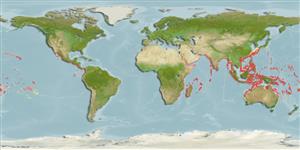Environment: milieu / climate zone / depth range / distribution range
Ecologia
marino associati a barriera corallina; non migratori; distribuzione batimetrica 100 - 200 m (Ref. 86942). Deep-water; 35°N - 34°S
Indo-West Pacific: tropical, known only from a few scattered localities.
Length at first maturity / Size / Peso / Age
Maturity: Lm 31.0 range ? - ? cm
Max length : 55.0 cm TL maschio/sesso non determinato; (Ref. 2295); common length : 35.0 cm TL maschio/sesso non determinato; (Ref. 2295)
Spine dorsali (totale) : 10; Raggi dorsali molli (totale) : 10; Spine anali: 3; Raggi anali molli: 10. The inner surface of the pectoral fin axil without scales. Overall color is silvery-gray with yellowish suffusion; scale margins are narrowly brownish. Indistinct dark blotches or bars are sometimes apparent on the body. The lips are whitish to yellow. The fins are yellow, faint brown spotting may be present on soft dorsal, anal, and caudal fins. A narrow blackish bar runs across the base of the pectoral fin.
Inhabits the outer edge of the continental shelf. Feeds on bottom-living invertebrates and small fishes. Caught mainly with bottom longlines and bottom trawls (Ref. 9775).
Life cycle and mating behavior
Maturities | Riproduzione | Spawnings | Egg(s) | Fecundities | Larve
Carpenter, K.E. and G.R. Allen, 1989. FAO Species Catalogue. Vol. 9. Emperor fishes and large-eye breams of the world (family Lethrinidae). An annotated and illustrated catalogue of lethrinid species known to date. FAO Fish. Synop. 125(9):118 p. Rome: FAO. (Ref. 2295)
IUCN Red List Status (Ref. 130435)
Threat to humans
Harmless
Human uses
Pesca: scarso interesse commerciale
Strumenti
Warning: mysqli::__construct(): (08004/1040): Too many connections in /var/www/html/includes/speciessummary.lib.php on line 2104
Can't connect to MySQL database fbquizv2. Errorcode: Too many connections
